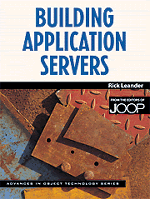Book contents
- Frontmatter
- Contents
- acknowledgements
- Introduction
- PART 1 ARCHITECTURE
- PART 2 DESIGN
- PART 3 PROGRAMMING
- Chapter 8 Implementing an Application Server Framework
- Chapter 9 Using Java to Build Business Objects
- Chapter 10 Persistent Objects: Communicating with Databases
- Chapter 11 Interfaces and Client-Side Communication
- Chapter 12 Enforcing Business Rules
- Chapter 13 Multiprocessing, Concurrency, and Transactions
- Chapter 14 The Next Generation of Business Applications
- Appendix: Setting up a Development Environment
- Index
Chapter 14 - The Next Generation of Business Applications
from PART 3 - PROGRAMMING
Published online by Cambridge University Press: 06 July 2010
- Frontmatter
- Contents
- acknowledgements
- Introduction
- PART 1 ARCHITECTURE
- PART 2 DESIGN
- PART 3 PROGRAMMING
- Chapter 8 Implementing an Application Server Framework
- Chapter 9 Using Java to Build Business Objects
- Chapter 10 Persistent Objects: Communicating with Databases
- Chapter 11 Interfaces and Client-Side Communication
- Chapter 12 Enforcing Business Rules
- Chapter 13 Multiprocessing, Concurrency, and Transactions
- Chapter 14 The Next Generation of Business Applications
- Appendix: Setting up a Development Environment
- Index
Summary
The application server model will be an effective approach for building software in the twenty-first century, but it is only one of many different options available to the business software developer. Mainframe computing is still effective for large corporations, as millions of lines of code still perform their tasks effectively every day. Two-tiered client/server also offers an excellent option for less intensive database applications and there are a host of different Internet technologies available to deliver applications to Web browsers. In addition to existing technologies, the rapid rate of change will continue to bring new computing models that will spawn new software technologies. Just as client/server was a response to desktop computers, and a host of new software technology appeared in response to the Internet, other new technologies will continue to rise and shape the way that we build software.
Looking into the future is a difficult and perilous task. Even the best minds in the industry have trouble seeing beyond the next few years. To see how well others have fared, I got out the book Programmers at Work, published in 1986 (Lammers 1986). The book is a collection of interviews with some of the industry leaders of the time; early Mac developers Jeff Raskin and Andy Hertzfeld, dBase author Wayne Ratliff, VisiCalc designers Dan Bricklin and Bob Frankston, and of course Bill Gates.
- Type
- Chapter
- Information
- Building Application Servers , pp. 369 - 392Publisher: Cambridge University PressPrint publication year: 2000



